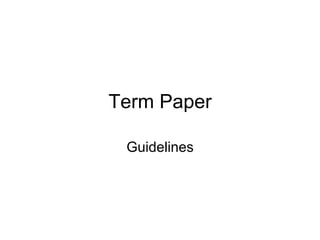Term paper presentation 2014 (1)
- 2. Important dates ŌĆóŌĆ» Deadline for Term paper application submission ŌĆō November 15, 2014 ŌĆōŌĆ» signature of the supervisor ŌĆōŌĆ» signature of the head of the program ŌĆóŌĆ» The title and the supervisor may be changed not later than February 24, 2015 ŌĆóŌĆ» Deadline for the final full text of the Term paper presentation to the supervisor ŌĆō March 24, 2015 ŌĆóŌĆ» Deadline for completed Term paper submission ŌĆō April 24, 2015 ŌĆōŌĆ» Submission is made by uploading the file into the system in your personal cabinet at http://www.wehse.ru ŌĆóŌĆ» Term paper defense ŌĆō during the period from the third Thursday of May 2015 to the first Thursday of June 2015
- 3. Important facts ŌĆóŌĆ» Size of the Term paper ŌĆō 1,5 authorŌĆÖs sheets (1 authorŌĆÖs sheet = 40000 typographical units with spaces) ------- 30 pages ŌĆóŌĆ» The Term paper will be evaluated in the Term paper Review form, filled out by the supervisor ŌĆóŌĆ» The Term paper will be checked by the Anti-Plagiarism program ŌĆóŌĆ» Bibliography (different standards) ŌĆōŌĆ» Campbell, W.C. & Ballou, S.V. (1990). Form and Style: Theses, Reports, Term Papers ŌĆōŌĆ» Porter M.E. The Competitive Advantage of Nations. N.Y.: Longman, 1990. 246 p.
- 4. Design ŌĆóŌĆ» Font ŌĆō Times New Roman, size 14 ŌĆóŌĆ» Interval ŌĆō 1,5 ŌĆóŌĆ» Margins: ŌĆóŌĆ» Left ŌĆō 35 mm ŌĆóŌĆ» Top & bottom ŌĆō 20 mm ŌĆóŌĆ» Right ŌĆō no less than 10 mm
- 5. Tips to follow ŌĆóŌĆ» Cover less material very well rather then more material only moderately well. Less is the new more.
- 6. Title ŌĆóŌĆ» Pick a title as early as possible and revise it as you go; try to be focused even with the title ŌĆóŌĆ» Be specific: title should give the reader a good idea of what they will find in the paper ŌĆóŌĆ» Put most important words at the beginning ŌĆóŌĆ» Find balance between length (too long is clumsy) and specific information (too vague is not effective)
- 7. Contents ŌĆóŌĆ» Introduction ŌĆóŌĆ» Theoretical Aspects: Theory and Previous Research on the Topic ŌĆóŌĆ» Analytical part: Method and data analysis / Case Study ŌĆóŌĆ» Results and ways of problem solving ŌĆóŌĆ» Summary and Conclusion ŌĆóŌĆ» References ŌĆóŌĆ» Appendices
- 8. Structure: Intro ŌĆóŌĆ» Indicate some context and motivation (why is this topic interesting to you) ŌĆóŌĆ» Relevance, timeliness, significance of the topic ŌĆóŌĆ» Touch briefly the missing pieces of the state of knowledge ŌĆóŌĆ» Object, subject and main goals ŌĆóŌĆ» Tasks / activities ŌĆóŌĆ» Methodology ŌĆóŌĆ» Summarize what the rest of the paper will discuss and bottom-line conclusion ŌĆóŌĆ» Not more that 3 pages
- 9. Theory and Previous Research ŌĆóŌĆ» Describe the existing studies on the topic (background) ŌĆóŌĆ» Identify weaknesses or omissions in the studies
- 10. Data analysis ŌĆóŌĆ» Statistics, surveys, case studies
- 11. Results ŌĆóŌĆ» Problems solved ŌĆóŌĆ» Findings ŌĆóŌĆ» Directions for further research
- 12. Citing references ŌĆóŌĆ» (1) If a citation in your text refers to a whole study, it should give the author's name and the year of publication. (Hofstede 1989) ŌĆóŌĆ» (2) If a citation in your text refers to a particular idea or statement in a study, it should give the author's name, the year of publication and the page number(s) where this idea can be found. (Hofstede 1989:15-17)
- 13. Citation in the Text ŌĆóŌĆ» Single author ŌĆōŌĆ» Kirby (2003) has explored the metaphor of managing diversity.... ŌĆōŌĆ» In a study (Kirby 2003) the metaphor of managing diversity coping was investigated.... ŌĆóŌĆ» Organization as author ŌĆōŌĆ» The National Research Council (NRC) (1989) has found that... ŌĆōŌĆ» ... premature death ... is diet-related (National Research Council 1989). ŌĆóŌĆ» Two authors ŌĆōŌĆ» In Write for business by Johnson and Swift (2000) ... ŌĆōŌĆ» High levels of job performance and job satisfaction occur when ŌĆ” (Goris and Johnson 2000:348). ŌĆóŌĆ» Three to six authors ŌĆōŌĆ» (Putnam, Phillips and Chapman 1996:35-40) the first time the study is referred to ŌĆōŌĆ» ... (Putnam et al. 1996:41) in subsequent references ŌĆóŌĆ» More than six authors ŌĆōŌĆ» Warner et al. (1995:5) define design as ŌĆ” the name of the first author followed by et al. ŌĆóŌĆ» No author ŌĆōŌĆ» ...(Enlarging the EU 2002:28) two or three first words of the title
- 14. Plagiarism ŌĆóŌĆ» Copying a paragraph as it is from the source without any acknowledgement. (Plagiarism) ŌĆóŌĆ» Copying a paragraph making only small changes, such as replacing a few verbs and adjectives with synonyms. (Plagiarism) ŌĆóŌĆ» Cutting and pasting a paragraph by using the sentences of the original but leaving one and two out, or by putting one or two sentences in a different order. (Plagiarism) ŌĆóŌĆ» Composing a paragraph by taking short standard phrases from a number of sources and putting them together with some words of your own. (Plagiarism?) ŌĆóŌĆ» Paraphrasing a paragraph by rewriting with substantial changes in language and organization, amount of detail, and examples. (Acceptable practice) ŌĆóŌĆ» Quoting a paragraph by placing it in block format with the source cited. (Acceptable practice)














